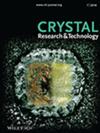溅射功率对柔性氟绿石衬底上ITO薄膜光电性能的影响
IF 1.9
4区 材料科学
Q3 CRYSTALLOGRAPHY
引用次数: 1
摘要
在本研究中,采用磁控溅射,在室温下将溅射功率从156调节到306 W,并在柔性氟绿岩衬底上获得氧化铟锡(ITO)薄膜样品。随着功率的增大,薄膜的电阻率先减小后增大。在276 W时电阻率最小为1.51 × 10-3 Ω cm,在156 W时电阻率最高为2.93 × 10-2 Ω cm。在156 ~ 276 W范围内,薄膜(400 ~ 800 nm)的平均透光率随功率的增加而减小,在156 W时平均透光率最高,达到92.6%。随着功率的增加,薄膜的品质因子先上升后降低,在276 W时达到4.47 × 10-3 Ω-1sq。所有AFMs都表明,样品的粗糙度随功率的变化不显著。SEM图显示,当功率从156 W增加到276 W时,晶粒尺寸略有增大。所有试样绕钢瓶弯曲1200次,片材电阻变化不大于5%。本文章由计算机程序翻译,如有差异,请以英文原文为准。
Effect of Sputtering Power on the Optical and Electrical Properties of ITO Films on a Flexible Fluorphlogopite Substrate
In this study, magnetron sputtering is implemented to adjust the sputtering power from 156 to 306 W at room temperature, and thin film samples of indium tin oxide (ITO) on a flexible fluorphlogopite substrate are taken. With the increase in power, the resistivity of the film first decreases and then increases. The resistivity is at least 1.51 × 10–3 Ω cm at 276 W, and the highest resistivity is 2.93 × 10–2 Ω cm at 156 W. The average light transmittance of the film (400–800 nm) decreases with the increase in power within the range of 156–276 W, The highest average transmittance is 92.6% at 156 W. The quality factor of the film first rises and then decreases as the power increases, it is as high as 4.47 × 10–3 Ω–1sq at 276 W. All the AFMs show that the roughness of the sample does not significantly change with power. The SEM picture shows that as the power increases from 156 to 276 W, the grain size increases slightly. All samples are bent 1200 times around a steel cylinder, and the sheet resistance does not change more than 5%.
求助全文
通过发布文献求助,成功后即可免费获取论文全文。
去求助
来源期刊
自引率
6.70%
发文量
121
审稿时长
1.9 months
期刊介绍:
The journal Crystal Research and Technology is a pure online Journal (since 2012).
Crystal Research and Technology is an international journal examining all aspects of research within experimental, industrial, and theoretical crystallography. The journal covers the relevant aspects of
-crystal growth techniques and phenomena (including bulk growth, thin films)
-modern crystalline materials (e.g. smart materials, nanocrystals, quasicrystals, liquid crystals)
-industrial crystallisation
-application of crystals in materials science, electronics, data storage, and optics
-experimental, simulation and theoretical studies of the structural properties of crystals
-crystallographic computing

 求助内容:
求助内容: 应助结果提醒方式:
应助结果提醒方式:


